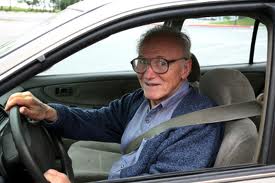Since every person ages differently, there are no hard and fast rules about when a person should set limitations on their driving or give up driving altogether. In our previous blog post on mature driver safety, we emphasized the self-assessment as the best tool to gage driving ability.
Sometimes unsafe signs come up gradually, or a recent change in health may make problems worse. As we age, it’s normal to have problems with eyesight, hearing, reflexes, range of motion and memory. A person may have an increase in incidents on the road, such as sudden lane changes, drifting into other lanes, braking or accelerating suddenly for no reason, failing to use turn signals properly, and frequent fender benders or close calls.
Some older drivers may be aware of their faltering ability but still be reluctant to give up driving completely. Another person’s concerns may force the senior driver to act. They may even feel relieved to have someone else help make the decision to stop driving. Some seniors may forget that they aren’t supposed to drive. If that is the case, it is even more important to remove the car or the keys to make it impossible to drive.
If you find yourself in the position of talking to an older adult about their driving, remember that a driver’s license signifies more than the ability to drive a car; it is a symbol of freedom and self-sufficiency. Driving is not a privilege that anyone wants to relinquish willingly.
Helpful tips when taking the keys
- Be respectful. For many seniors, driving is an integral part of independence. Many older adults have fond memories of getting a driver’s license. At the same time, don’t be intimidated or back down if you have a true concern.
- Give specific examples. It’s easier to tune out generalizations like “You just can’t drive safely anymore.” Outline concerns that you have noticed, such as “You have a harder time turning your head than you used to,” or “You braked suddenly at stop signs three times the last time we drove.”
- Find strength in numbers. If more than one family member or close friend has noticed, it’s less likely to be taken as nagging. A loved one may also listen to a more impartial party, such as a doctor or driving specialist.
- Help find alternatives. The person may be so used to driving that they have never considered alternatives. You can offer concrete help, such as researching transportation options or offering rides when possible. If your family member is reluctant to ask for help, it can lead to isolation and depression.
- Understand the difficulty of the transition. Your loved one may experience a profound sense of loss having given up driving. Don’t dismiss their feelings but try to help with the transition as much as possible. If it is safe, try slowly transitioning the senior out of driving to give them time to adjust. For example, your loved one may begin the transition by no longer driving at night or on highways, or by using a shuttle service to specific appointments or destinations.
When an older driver refuses to give up the keys
Sometimes an older driver has to be stopped from driving over their objections. It might feel very difficult for you to make this call, especially if the senior is a parent used to having their independence. However, their safety and the safety of others must come first. An unsafe driver can seriously injure or kill themselves or others.
If appropriate evaluations and recommendations have been made, and no amount of rational discussion has convinced the driver to hand over the car keys, then you may make an anonymous report to your state’s Department of Motor Vehicles (in the U.S. or Canada) or talk to the person’s physician about your concerns. In some cases, there is a need to take further actions such as taking away the car keys, selling or disabling the car, and enlisting the local police to explain the importance of safe driving and the legal implications of unsafe driving.









